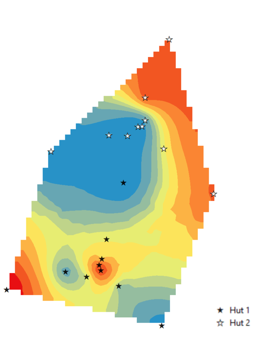
The human disturbance study addresses the third hypothesis (H3) of the MCM V proposal: ‘Disturbance increases connectivity and accelerates shifts towards homogeneity in ecosystem structure and functioning in the MDVs.’ By using historical research alongside soil sampling at sites of past human activity in the MDV, the human disturbance study sets out to assess the long term (30+ years) legacy of human activities on the MDV ecosystem.
During the 2017 to 2018 season we visited four sites in the McMurdo Dry Valleys where field camps existed in the past, but have since been removed (Brownworth, Meserve, Asgard, and Canada Glacier). At each of these sites the exact location of the former structures was identified using historical photographs. A center point was established at the middle of this location and 3 soil samples were taken at the corners of an equilateral triangle with 1m sides. Working out from the center directly to the north we took 3 samples at 5m, 15m, and 45m using the same 1m triangular sampling. This was repeated going out from the center at 120 degrees, and 240 degrees, giving a total of 30 samples for each structure. At each site, up to 3 locations of former structures or installations (e.g. outhouses, helo landing sites, other structures) were sampled in the same way, depending on the set up of the former field camp. Since the Lake Brownworth location had two hut sites, additional sampling was conducted here.
Nematode counts and basic soil chemistry have been taken for each sample. The samples are currently being sequenced and advanced soil chemistry measurements taken. Initial results from the nematode counts and bacterial diversity suggest that there may be a long-term influence of soil disturbance associated with historic camps and structures on soil communities, but more data is needed before more definitive conclusions can be drawn.
The human impacts study is taking place within the wider context of work on the environmental history of the MDV being coordinated by Howkins. Archival research has been conducted in the United States, New Zealand, Japan, Australia and the United Kingdom and around 25 oral history interviews have been conducted with scientists who have worked in the region. Some of the results from this research can be found at http://mcmurdohistory.lternet.edu/. A book on the environmental history of the MDV is being written and will be submitted for publication to a major university press before the completion of the MCM5 grant. This work has a tremendous potential to inform environmental management policies in the region, as demonstrated by the environmental report edited by Priscu and Howkins (2016).
